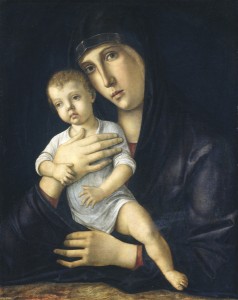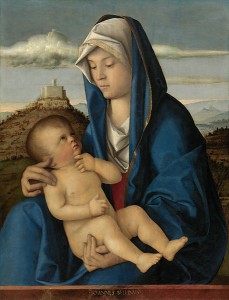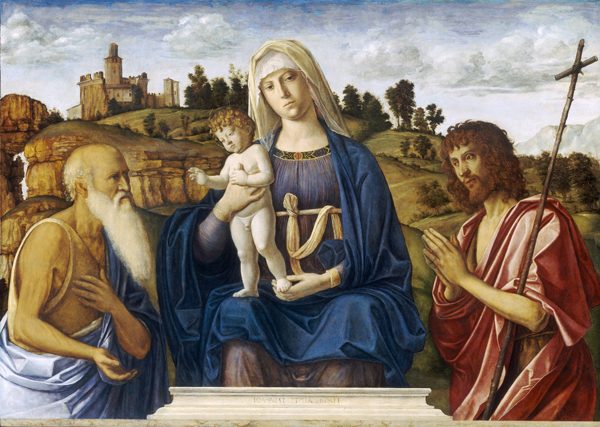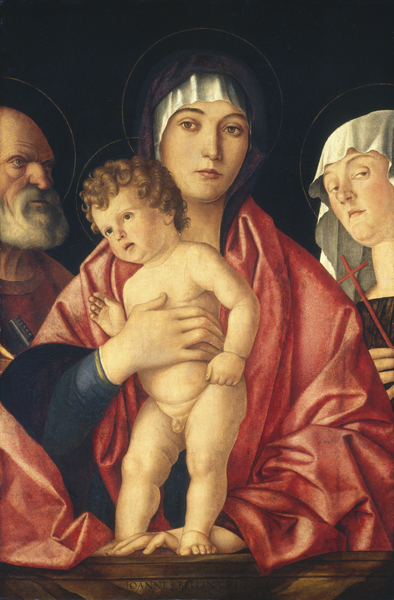Giovanni Bellini is considered the father of Renaissance painting in Venice. For him and his busy workshop, devotional images of the Virgin and Child were mainstays. Between about 1460 and 1500 they painted countless half-length Madonnas, revolutionizing the image in the process. Rather than faithfully copy the look of the old Madonnas, Bellini attempted, in the words of one scholar, a “spiritual likeness.”10 Bellini’s works share with icons a sense of monumentality, isolation, and austerity—a grave spirituality. Above all, it is Bellini’s use of light that conveys the mood; luminosity evokes a numinous presence. His figures are radiant, his landscapes lit by a dawn glow; light fills the entire space of his compositions. Bellini was among the first to master the new techniques of oil painting, which made this brilliant color possible.
Monumentality, Isolation, and Austerity
Its austere background lends the solemnity of an icon to the panel on the left, and the Virgin’s oval face, arched brows, and long, elegant features are similar to those of a Byzantine Madonna. So is the rounded contour of the mantle drawn low over her brow. The child’s robust three-dimensional body and energetic posture, however, do not at all recall the way icon painters presented the infant Jesus—as a miniature adult in a regal, frontal pose. Here he steps onto the parapet as his mother wraps him protectively in her cloak. She looks out pensively to the viewer communicating the sad knowledge of her child’s future sacrifice, which he too appears to consider, with a pensive sidelong gaze. Bellini achieves the spiritual power of an icon with the radiance of the figures, who seem almost to glow with an internal light.
In the later painting by Bellini on the right, the Virgin and Child are set before a cloth of honor beside which a slice of landscape extends to the distance. The Virgin is large and imposing, with the frontal monumentality of an icon. The stable pyramidal grouping emphasizes the stillness that seems to surround the pair.
Beginning around 1500, Bellini painted fewer images of the Virgin and Child alone and instead added saints on either side. Essentially, these compositions were reduced versions of the sacra conversazione, a type especially popular for altarpieces. In the 1520s the sacra conversazione was the most common sort of painting in Venice. Its wider horizontal format invited experimentation with scenes that depicted the Virgin and Child set within a landscape, sometimes at three-quarter or even full length. In addition to paintings by Bellini’s hand, there are many produced by members of his shop. Some were probably made from cartoons of Bellini’s own paintings and reproduced with only minor variations. Others may have been assembled, smorgasbord-like, from motifs in pattern books.
Sacra Conversazione
Notice the similarities and small differences between these two panels, which illustrate the kinds of copies and variants Bellini’s shop produced. In the first the Virgin hands a fruit—perhaps a small apple, suggesting the Fall of Man—to the infant Jesus. The parapet acts like an altar and recalls Christ’s presence in the Mass. More than through symbolic means, however, Bellini conveys the spiritual through light. In the landscape, dawn hovers in a golden layer above the horizon, suffusing the undersides of clouds with glowing color.
Cima da Conegliano
Cima da Conegliano may not actually have studied with Bellini but was nonetheless greatly influenced by his works. While Bellini was involved with decorations of the doge’s palace, Cima assumed Bellini’s place as the leading painter of altarpieces in the Veneto region. The size of the panel shown here suggests that it might have been commissioned as an altarpiece, a reduced version of the sacra conversazione with standing, full-length, flanking saints that was most popular in church settings. In Cima’s painting the saints are Jerome and John the Baptist, who embodied ideals of penitence and sacrifice. In the painting made by a Bellini follower, Saint Peter is modeled on a figure by the master, but the female saint is unidentified and her smug expression seems removed from the spiritual quality of Bellini’s own devotional works.
Bellini’s Madonnas maintain a certain psychological distance. The next section considers images of the Virgin and Child painted primarily in Florence, where artists conveyed a greater sense of humanity and familiarity, and a more worldly connection to the viewer’s present, than did Venetian painters.
Madonna of the Meadow
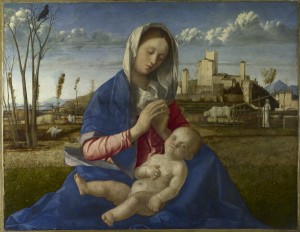
Giovanni Bellini
Madonna of the Meadow, c. 1500
Oil and tempera on synthetic panel, transferred from wood, 67.3 x 86.4 cm (26 1/2 x 34 in.)
The National Gallery, London
© National Gallery, London/Art Resource, NY
In the distance of Bellini’s panel are the farms and hill towns of Venice’s mainland territory. Light fills the painting like a divine presence. A new emphasis on the landscape reflects the preaching of Franciscan brothers, who taught that the sacred was to be sought in all of nature. Bellini’s figures, however, remain remote, retaining a certain iconlike formality. The pose of the infant on his mother’s lap anticipates the pietà, but mother and child do not interact with the landscape; they appear to be situated before it more than in it.
